|
Carlos Manuel de Carvalho
Surgeon at Lagoa Hospital in Rio de Janeiro, specialist in thoracic surgery. He is 54 years old and has been living in Rio de Janeiro for 46. |
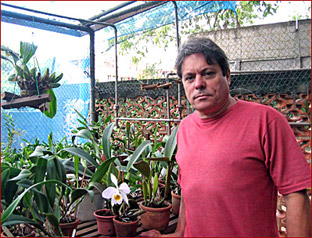 |

|
Carlos Manuel de Carvalho
Surgeon at Lagoa Hospital in Rio de Janeiro, specialist in thoracic surgery. He is 54 years old and has been living in Rio de Janeiro for 46. |
 |
| ON: Why
did you start to cultivate orchids? Which was the magic moment of the attraction? My interest in orchids arose, how odd it could be, with the most common orchid, Epidendrum denticulatum which grows in a tree-fern in Mauá, next to our home. I was puzzled by those clusters of small lilac flowers which stay open all year round. |
| With
a magnifying glass, I have been surprised to see that it was, in fact, an
orchid flower similar to those I have already seen in some places and photos,
though they were bigger. Thus, I decided to look for an old book I have
received when I was a child which has some photos, almost of them black
and white but some were handy painted. It was nothing less than João S.
Decker's book called "As Orquídeas e sua Cultura" (The Orchids and their
culture), an edition of 1956 and illustrated by Lilly Althausen. I believe
that, the moment I decided to look for some information about those flowers,
I have already got this "disease". I think that "orchidmania" appears the exact moment |
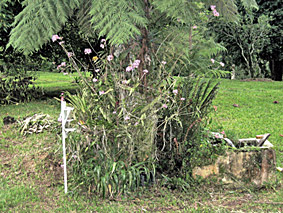 |
| you
stay puzzled by that flower, no matter which species it is. Then, it is
easy to imagine: "Look! another one, another kind! Which orchid it can be?"
And we get more books, we look here and there and we have already got the classificatory fever. By this time, I realized that I needed some orientation and I got OrquidaRIO's telephone number, figure out, in a show in São Paulo. I became an associated and after that, the continuation is known. I wanted to have all of them, to cultivate all them and started another "mania": to sow orchid seeds. |
| ON: How
long do you cultivate orchids? I started at about ten years ago and from the looks of things, it tends to last "per omnia secula seculorum". |
| Of course, I don't cultivate as I did at the beginning, I have
more discernment about the quality of the plants and quantity of genera.
Nowadays, I tend to be restraint to Laelias and Cattleyas, here in Rio de Janeiro city and to Oncidium, in Mauá (Mountainous region). Diversifying too much makes accentuated difficulties to cultivate, since you should place, side by side, plants with different needs concerning watering, light, etc... |
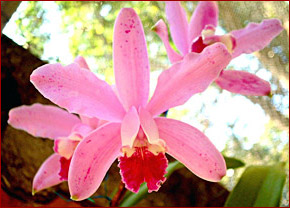 |
| If you want to have various genera and species, you should choice
plants with similar needs for cultivation. It makes easy to take care of them. ON: How many plants do you have nowadays, approximately? Totally, I have at about 1500 adults plants and plantules already potted and at about 500 plantules in flasks to be potted. |
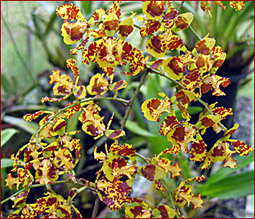 |
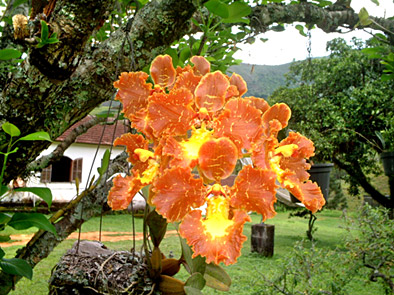 |
ON: Which species do you have more? Which one is your
favorite? The most part is Laelia, Cattleya and relatives and also Oncidium, mainly Oncidium crispum which is, these days, my "sweetheart" between all of them, especially because it won the trophy of the best plant of the last orchid show at Botanical Garden of Rio de Janeiro. ON: Where do you cultivate yours plants? I have my plants in Botafogo, in Rio de Janeiro city, at sea level and in Visconde de Mauá, situated in the border of the states of Rio de Janeiro and Minas Gerais, at 1.100m altitude. |
| ON: Do you prefer hybrids or species. Why? I prefer species. The most part of the sowed plants I have is species. Between those plants, just a small part is hybrid. Perhaps because I started to be interested in orchids with small flowers (Epidendrum denticulatum), I am not impressed by big hybrids, so wished by some, mainly, by "non-expert". I have the sensation that those flowers are made by satin and spangles. My hybrids are always plants which have flowers more interesting than exuberant. |
| I can mention Blc. Keowee that I find beautiful although it doesn't obey the standard criterions of wide sepals and petals closing all the flower. As a matter of fact, that is the most beautiful to me in this hybrid. I mean, see the shape of Brassavola, with its long and narrow petals and sepals. I played to be hybridizer and my hybrids have obeyed my taste. I repeated, for example, a primary hybrid between C. walkeriana and C. forbesii, called C. Ching Li Sa that resulted, in my opinion, in very agreeable form and color. | 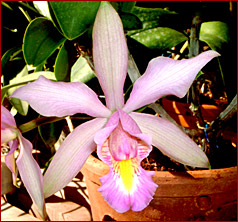
Cattleya Ching Li Sa
|
| In this way, I also did a known hybrid (O. Vroni Keller- Oncidium crispum x Oncidium flexuosum) using |
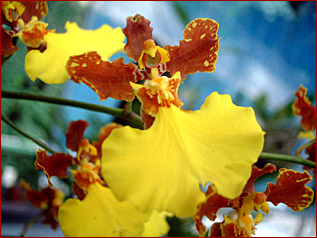 Oncidium Vroni Keller |
a
good O. crispum and it surprised me. It bloomed with just three years,
here, in Rio de Janeiro city, stayed with a wonderful blooming for 45 days
and bloomed again six months later. Besides, unlike Oncidium flexuosum,
it has the close pseudobulbs which make easy to have it potted for long
time. In spite of this success, I still think that it is worth to cultivate
what the nature took millions of year to do, through an evolution by a so
close association with the pollinators that if one disappears, it can provoke
the extinction of the other. The diversity of forms, colors, scents and vegetative habits which aim the fecundity make the species fascinating to me. I believe that, if I had commercial aims, may be I would cultivated the "big" hybrids and I consider |
| it absolutely OK, since the production is determined by the search of this kind of flower which always creates a great impact in any environment. |
| ON: How
long do you spend taking care of your orchids, daily? In general, I visit my orchids daily and do a quick inspection to see if there is some cultural ailments or pest. I also water the plantules which are in clay pots because they dry out quickly. It takes me about half an hour daily. During the weekends, I spend Saturdays and Sundays morning taking care of the nursery. Concerning the orchids in Mauá, due to the fact that they are native of the region and because it is far from Rio (so I see them once or twice a month), they stay on their own. They grow incredibly very well. |
| ON: Which are the climatic conditions of each environment
? In Rio de Janeiro city, we have more heat or less heat and a rainy summer. So I have a covered greenhouse, in order to control the watering. |
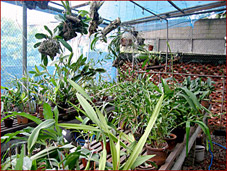 Greenhouse in Botafogo |
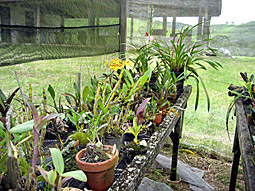 Visconde de Mauá |
At Visconde de Mauá, the seasons are well defined and so the rain period too. The winter is very dry and by July, there is much frosts and, at least three or four times during the month, the temperature goes down at two or three degrees negative. Those conditions are fundamental to induce Oncidium, Bifrenaria, Zigopetalum, etc... blooming during the springtime. It rains a lot during the spring time and goes on trough the summer until the end of March or beginning of April. As I just have orchids coming from this region, the staging is open and just covered with lighter-weight shading material forming a network. Thus the plants are submitted to the local regimen of rains and temperatures. |
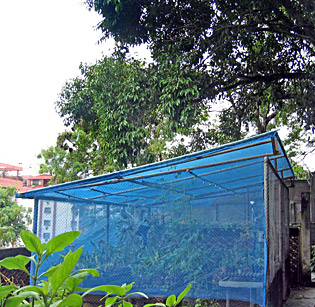 |
ON:
Could you tell us how you cultivate in each environment? As I have already said, in Rio de Janeiro, I have a controlled cultivated with the usual phyto-sanitary cares and fertilizers. I fertilize every fortnight and at the beginning of each season, I add a small quantity of Ricinus' bran mixed with wood ash and bone flour in the proportion of 1:1:1. The greenhouse is covered with a 100-micra plastic de thickness, transparent, fastened to a nylon wire fencing. Unfortunately there is a Jamelão tree which gives too much shade and throws any kind of litter on the cover. As a result, frequently, I also have many insects attacking the plants. |
| In
Mauá, I fertilize once a month, when I go there. Almost orchids are planted
in small wood logs, in general "pereira" or orange trees, in order
to simulate as closer as possible their own environment. Many of those "supports" are hanged in the trees, out of the staging. As a matter of fact, the most part of the native orchids are maintained on the trees since I much care to keep them in their original environment. I use to pollinate them, mainly Oncidium crispum, which hasn't been showing spontaneous fructification for many years. I am afraid the local pollinator has disappeared due to the deforestation, fires and agricultural toxic products used. Oncidium welteri, Oncidium gardneri, Oncidium cruciatum, Maxilarias, Zigopetalum and Bifrenarias go on being naturally fecundated. |
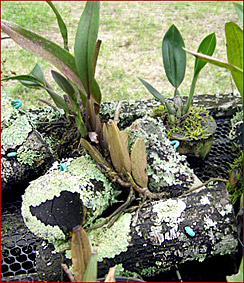 |
| ON: You did an interesting hybrid joining
two different conditions of cultivation. Which was it and which are the
advantages ? This hybrid is exactly Oncidium Vroni Keller that I have already mentioned. The aim was to improve the flower of Oncidium flexuosum, using its rusticity and the possibility of being cultivated in many different environments and injecting the quality of the flower of Oncidium crispum which is, on the other hand, very demanding to bloom regarding to the environment. |
| ON: Do
you have a cultivation tip to share with us? As a tip, I just suggest that who has difficult with Oncidium, use a clay pot with a little quantity of tree fern fiber or, better, put it in small branches of trees as I do. They grow well in this kind of support which is very easy to make. You just have to join three small branches putting the tip of the one under the other, forming a triangle. Just a small quantity of tree fern fiber in the center to help with the required humidity to make the plant roots. All Oncidium I had trouble, grow well in this kind of support. |
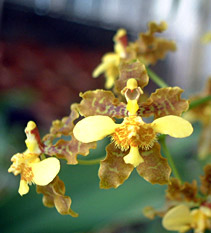 o. barbatum |
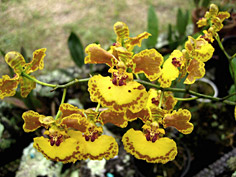 o. gardneri |
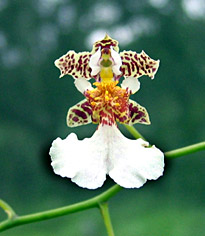 o.
warmingii o.
warmingii |
|
ON: Is
there a short or an amusing story connected to orchids that you want to
tell us? One
said that orchidophilia is a soft manifestation of madness. Have you done
any "orchidophilic" insanity? |
|
Any
kind of reproduction (print, digital or anyone other) of
any type of
material of this
site - texts, layout,
photos, images and others - is strictly forbidden without the previous written permission of the authors. Any solicitation or information should be done by the e-mail bo@sergioaraujo.com |